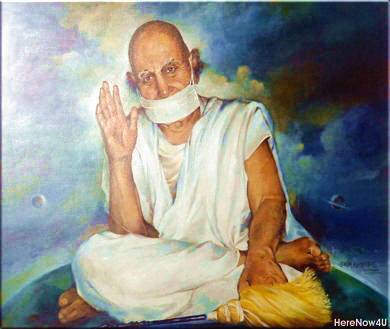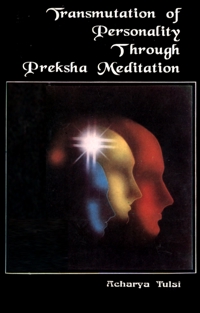
Like a dark cloud, or collyrium, or the black crow,
Or a buffalo's horn is krishna leshya coloured;
The wing of the blue bird, the precious emerald
And the Asoka tree, give their blue to neel leshya;
Kapot leshya is grey like a pigeon's neck,
Like linseed flowers and the wings of a cuckoo;
Red like vermilion or a lamp's flame
And the rising sun, is teloleshya's grand sphere!
Like turmeric and orpiment and blossoming hemp flowers,
Yellow is the colour of padma leshya clean!
Like silver, a conch-shell, a jewel, a garland of pearls,
A white flower, or a stream of milk, is most desirable leshya shukla!
Colour, smell and taste, etc. are the qualities of matter, therefore devoid of consciousness.
The current of feeling is something living.
No attribute of a living being can be lifeless.
The aura is lifeless.
Colour, smell, taste etc. are important in identifying it.
But how can the current or leshya of feeling be identified through these?
The soul of the world is neither soul nor matter in the essential meaning of these terms, it is a combination, an alloy of soul and matter. In terms of Jain philosophy, it is a progression, a vigorous sequence. Man, too, is a sequel thereof. The attribute of the soul is consciousness. The attributes of matter are colour, smell, taste and touch. Feeling is psychic and the aura is physical. The feeling and the aura both have a deep, mutual relationship. Thus, it is possible to interpret the aura through feelings, and the feelings through the aura.
The six leshyas, by their very names, are indicative of their colours.
Still, for the sake of greater clarity, will you kindly give us a practical introduction to these?
Uttaradhyana Sutra contains an exposition through examples of the leshya colours.
The following description is based thereon:
- Krishna leshya is black like dark cloud, collyrium, the pupil of the eye, a black crow, and a buffalo's horn.
- Neel leshya is dark blue like the wing of a blue bird, emerald, and the Asoka tree.
- Kapot leshya is grey as a pigeon's neck, linseed flowers and the wings of a cuckoo.
- Tejo leshya is red as vermilion, ochre, the flame of a lamp and the rising sun.
- Padma leshya is yellow as turmeric, orpiment, and hemp flowers.
- Shukla Leshya is white like a conch-shell, a gem, silver, & garland of pearls, a white flower and a stream of milk.
A living being does not have only one Leshya, and different leshyas have different colours.
Is the aura of a living being possessed of many leshyas, of some special kind, or is there in it a combination of different colours?
The aura is not only of one colour. In it there is a combination of many colours, because it evolves out of many leshyas. The colours of leshyas depend upon an individual's particular feelings. Certain feelings are predominant in a particular individual. The leshya colours take after those predominant feelings. Whatever colours are there in the leshya, are also reflected in the aura. Good feelings are white, bad feelings black. On the basis of colours reflected in the pictures taken of the aura, even feelings changing from moment to moment can be grasped.
Can pictures be taken of the aura?
It is not very difficult to take pictures of the aura. Many scientists are engaged in research and experimentation in this connection. The photographs taken by the Russian scientists, the Kirlyan couple, are quite famous. An American woman, J.C. Trust has written a book entitled Atom and Aura. This book is not a collection of imaginary or predominantly ideological facts. The writer has taken pictures of the aura or the ring of light and has printed them. These pictures have been analysed.
What kind of aura a person has is not dependent upon his outward appearance. There are some people whose clothes are dirty, whose complexion is dark, whose features are not at all attractive, yet their aura may be very bright. On the contrary, those who wear clean clothes, are fair complexioned, have a high standard of living and have daily correspondence with the great, may have an extremely filthy aura.
The above facts are indicative of the mystery that no man can be truly known on the basis of his outward appearance. Some white collared people have no hesitation in committing terrible crimes. Their appearance and conversation gives no hint whatever that these people are capable of perpetrating such heinous acts. But the filthiness or darkness of their aura clearly reveals their inward nature.
You have said that a true assessment of personality can only be made on the basis of an individual's aura.
If someone's aura is dirty and he comes to know it, he would want to make it bright.
What is the simple process of making one's aura bright?
The process may be simple or complex, but he who wants to become or achieve something, will have to pass through it. The moment a keen urge is aroused in the mind, an individual is ready to traverse even the most difficult path. Possessed by an indomitable desire to reach Ratnawali, Saint Tulsi Das crossed the raging stream with the support of a swollen corpse. Otherwise, one dare not stir abroad on an awful night like that.
Similarly, in the field of sadhana, too, there is need for awakening such an indomitable desire. The man who wants to make his aura radiant, must first of all concentrate on purifying his feelings. When the purification of feelings aims at promoting awareness and alertness, a transformation of the aura begins of itself. As sadhana for awareness and alertness matures, the aura becomes brighter and still more bright. There is a way to achieve it, constant practice of preksha and anupreksha.
Can the direction of life be changed by merely making the purification of feelings as one's aim?
The determination of one's aim brings about integrated thinking. This intensifies mental impressions. Such deep impressions can be a chief factor in changing one's direction of life. Many women are so conditioned that if a bad thought enters their mind, they cannot rest content until they altone for it by doing some penance. Such a development would be unimaginable in the case of an aimless person. So there should not be any difficulty in recognising that the determination of a goal is a prominent factor in changing the direction of one's life.
 Acharya Tulsi
Acharya Tulsi
